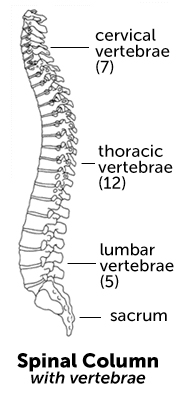Spinal Fracture | Diagnosis & Treatments
How is a spinal fracture diagnosed?
Your child's physician will make a diagnosis with physical examination and diagnostic tests. During the examination the physician obtains a complete medical history of your child and asks how the injury occurred.
Diagnostic procedures include:
- X-rays: a diagnostic test, which uses invisible electromagnetic energy, beams to produce images of internal tissues, bones, and organs onto film. This test is used to measure and evaluate the curve.
- Computerized tomography scan (also called a CT or CAT scan): a diagnostic imaging procedure that uses a combination of x-rays and computer technology to produce cross-sectional images (often called "slices"), both horizontally and vertically, of the body. A CT scan shows detailed images of any part of the body, including the bones, muscles, fat, and organs. CT scans are more detailed than general x-rays and may help the doctor determine what type of fracture your child has.
- Magnetic resonance imaging (MRI): a diagnostic procedure that uses a combination of large magnets, radio frequencies, and a computer to produce detailed images of organs and structures within the body. This test is done to rule out any associated abnormalities
Overall goal of spinal fracture treatments
The goal of spinal fracture treatment is the restoration of normal length and alignment of the vertebrae, and avoidance of motion between the fracture fragments. Specific treatment for a fracture will be determined by your child's physician based on:
- your child's age, overall health, and medical history
- extent of the fracture
- your child's tolerance for specific medications, procedures, or therapies
- expectations for the course of the fracture
- your opinion or preference
How do we treat spinal fractures?
Treatment at Boston Children's Hospital may include some combination of the following:
- Brace: immobilizes the injured area to promote bone alignment and healing to protect the injured area from motion or use. Bracing helps reduce acute pain by immobilizing the fracture and helps reduce the eventual loss of height and in angulation from the fracture. Immobilization of a cervical spine compression
- Fractures usually involve the use of a rigid collar.
- Medication (for pain control)
- Reduction: involves realignment of the fractured bone. This can be done through an incision made into the fracture site (open reduction) or by external manipulation without an incision (closed reduction)
- Traction: the application of a force to stretch certain parts of the body in a specific direction. Traction consists of pulleys, strings, weights, and a metal frame attached over or on the bed. The purpose of traction is to stretch the muscles and tendons around the broken bone to allow the bone ends to align and heal.
- Surgery: required to put certain types of broken bones back into place. Occasionally, internal fixation (metal rods or pins located inside the bone) or external fixation devices (metal rods or pins located outside of the body) are used to hold the bone fragments in place to allow alignment and healing.
How Boston Children's Hospital approaches spinal fractures
Boston Children's Spinal Program in nationally and internationally known for its innovation and leadership, offering the latest diagnostic and treatment approaches. Our physicians with the Spinal Program see more than 6,000 outpatients and perform more than 300 spinal operations.
Long-term outlook for a spinal fracture
With proper immobilization and rehabilitation including physical therapy and exercise, most children can expect to make a full recovery from a spinal fracture.


